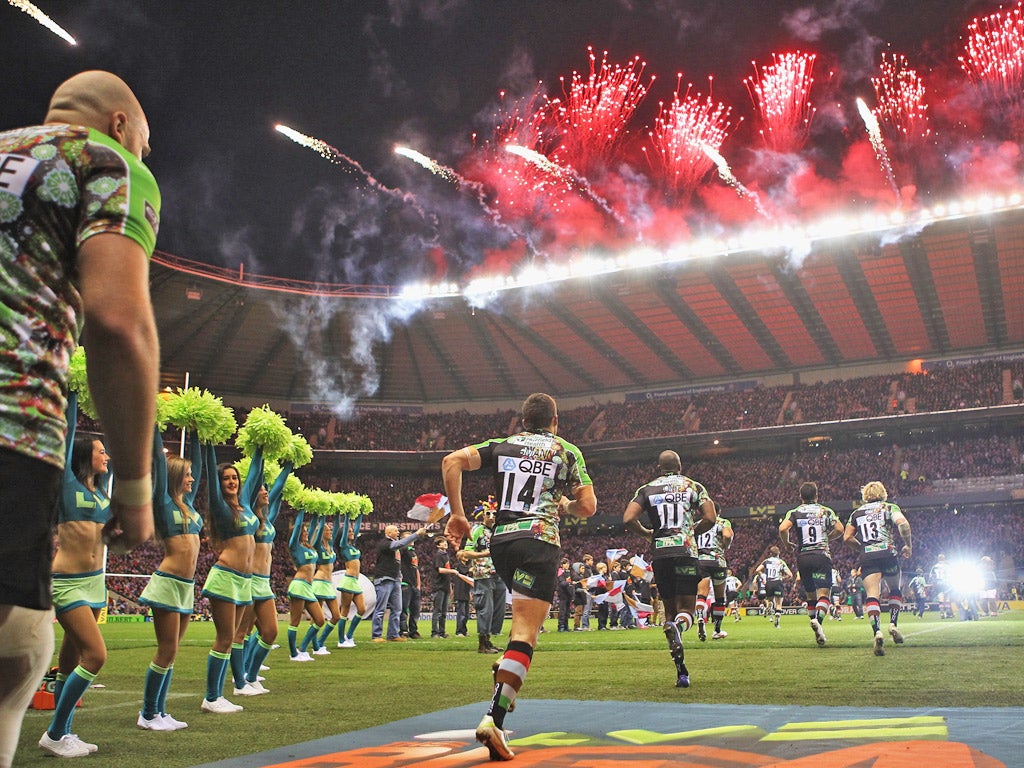In the long term, Quins must Stoop to conquer
Filling Twickenham was a feat but clubs have to attract regular big crowds – at their own grounds

English rugby does not often speak with one voice – in recent years Twickenham has been the sporting equivalent of a modern-day Tower of Babel – but there was definitely a common language to be heard as the game celebrated a record-breaking gate of 82,000 for this week's table-topping contest between Harlequins and Saracens.
The Premiership leadership talked enthusiastically of supporters voting with their feet, while Rob Andrew, the governing body's professional rugby director, congratulated Quins on their "fantastic achievement" in virtually selling out the biggest union-dedicated stadium in the world.
The idea of the Rugby Football Union going out of its way to revel in the success of its sometimes troublesome top-flight clubs would have been spectacularly far-fetched as recently as last month: under the deeply divisive chairmanship of the largely discredited Martyn Thomas, the atmosphere was one of fear and loathing.
But Thomas has disappeared into the past tense, taking the old negativity with him. Yesterday, Andrew praised Quins to the high heavens for their sense of ambition, their marketing ingenuity and their commitment to selecting young, England-qualified players rather than elderly southern hemisphere journeymen in search of a pension.
By beating the previous high attendance mark for a regular season club game – the 2009 Top 14 match between Stade Français and Clermont Auvergne in Paris is now a mere detail of history – the two London rivals drove the holiday weekend's Premiership-wide attendance through the 125,000 barrier. There were full houses at Kingsholm, where Gloucester put six tries past Wasps; at Franklins Gardens, where Northampton beat Bath; and at Sixways, where Worcester squared up to Leicester and finished a distant second.
In addition, London Irish drew upwards of 13,000 to the Madejski Stadium for their victory over Exeter, while the 9,000-plus who watched Sale squeeze out Newcastle was the highest Edgeley Park attendance for two years.
According to the latest arithmetic, this is part of an encouraging upturn. "The Aviva Premiership has never been in a stronger position," said Mark McCafferty, chief executive of Premier Rugby, the leading clubs' umbrella organisation. "The rivalries we have at the top and bottom of the league are some of the most intense in the world."
McCafferty released figures showing that crowds had risen by 10 per cent since the World Cup in New Zealand, which ended in late October. Such numbers are not always accurate in illustrating the underlying trend: depending on the identities of the promoted and relegated teams each year, cumulative attendances vary significantly.
But even allowing for the presence of Worcester in this season's competition – generally a good thing for business, given the club's increasingly strong spectator base – the latest statistics are reassuring. This term, crowds are up by two per cent on 2009-10.
Not that the garden is entirely covered by roses in full bloom. Tuesday's derby at Twickenham amounted to a one-off, or at least a once-a-year production, positioned at the optimum point of the Christmas period and heavily marketed. Based on an original idea from the far side of the English Channel, where the flamboyant Stade Français owner Max Guazzini regularly sold out Stade de France for the most attractive club fixtures, Quins have become adept at packing them in at Twickenham. Yet they rarely sell out at The Stoop, their regular home across the road, even though the capacity is some 68,000 down on Twickenham.
Wasps have also taken to playing an annual match at the home of English rugby, on St George's Day, or thereabouts, yet they struggle to attract an audience worthy of the name to Adams Park, the desolate venue in High Wycombe. Saracens, the reigning Premiership champions? Ditto. When they move a game to Wembley and work hard on publicising the event, they can pull in 40,000. When they play at Vicarage Road in Watford, they can hide the crowd in the players' tunnel.
It is becoming increasingly apparent that the traditional rugby towns and cities – Gloucester, Leicester, Northampton and, since promotion a couple of seasons back, Exeter – are a long way ahead of most in terms of building a business, largely because they own their grounds. So too do Harlequins, who happen to be based in the most rugby-conscious area of the capital, and Worcester, who are convinced they can make professional rugby work for them. The rest – those like London Irish, Sale, Saracens and Wasps, who have groundshare arrangements with football teams; or Bath, a club with deep roots in their community who just happen to play their rugby on perhaps the most fought-over rectangle of sporting land in Europe – are slipping behind.
With 50 per cent of Premiership fare broadcast live, those clubs playing either at sub-standard venues or those too large to generate an atmosphere are at an ever greater risk of making unsustainable losses.
For now, though, the Premiership feels good about itself. Christmas business was exceptional, the New Year holiday fixtures will be well attended, and the fight for Heineken Cup qualification and against relegations means there will be precious few dead matches.
There is no immediate cause for alarm. Just so long as England's reunited rugby family does not mistake short-term gain for long-term security.
Subscribe to Independent Premium to bookmark this article
Want to bookmark your favourite articles and stories to read or reference later? Start your Independent Premium subscription today.

Join our commenting forum
Join thought-provoking conversations, follow other Independent readers and see their replies